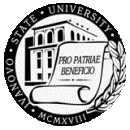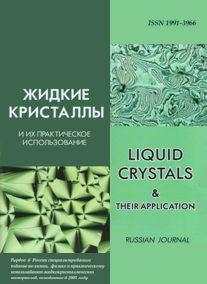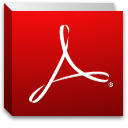|

|
Liquid Crystals and their Application
Russian Journal Zhidkie kristally i ikh prakticheskoe ispol'zovanie Жидкие кристаллы и их практическое использование |

|
|

|

|
|
|
Menu

|
|
|
|
|
Zhidk. krist. ikh prakt. ispol'z. = Liq. Cryst. and their Appl., 2021, 21 (4), 47—52.
DOI: 10.18083/LCAppl.2021.4.47 |

|
|
Surface Relief of Polyimide Thin-Film Orienting Materials for Liquid Crystalline Light Modulators
|
N. V. Kamanina1,2,3*, A. S. Toikka1,2,3, G. N. Zvereva4, P. V. Kuzhakov1,3, Ya. V. Barnash2,3, S. A. Tarasov2
|
Author affiliations
1Vavilov State Optical Institute, Saint- Petersburg, Russia
Scientific and Production Association «Vavilov State Optical Institute», Saint- Petersburg, Russia
2Saint-Petersburg Electrotechnical University («LETI»), Saint-Petersburg, Russia
3SRC “Kurchatov Institute – Petersburg Institute of Nuclear Physics, Gatchina, Russia
4Saint-Petersburg University of Civil Aviation, Saint-Petersburg, Russia
*Corresponding author: nvkamanina@mail.ru
|
|
Abstract
Various surface reliefs of thin-film polyimide compositions structured by different methods using UV and IR radiation are considered for subsequent recommendations of their application in the light- and electro-addressable liquid crystalline spatiotemporal light modulators. Spectral measurements were carried out and contact wetting angles of the structured surface were determined. The atomic force analysis of the structured surface was also performed. Based on the obtained data, it is proposed that the performed product developments can be effectively used for the design of laser radiation modulators and converters, in which a liquid crystalline mesophase functions as an electro-optical modulating layer.
Keywords: оrganic materials, polyimide layers, laser interaction in the UV and IR-spectral range, surface relief, wettability
|
For citation: Kamanina N.V., Toikka A.S., Zvereva G.N., Kuzhakov P.V., Barnash Ya.V., Tarasov S.A. Surface relief of polyimide thin-film orienting materials for liquid crystalline light modulators. Liq. Cryst. and their Appl., 2021, 21 (4), 47–52 (in Russ.). DOI: 10.18083/LCAppl.2021.4.47.
|
|
|
|
|
|
|




